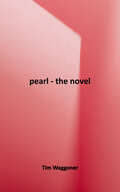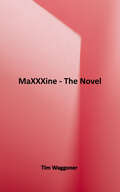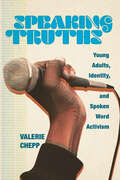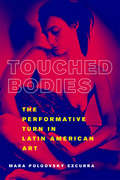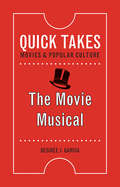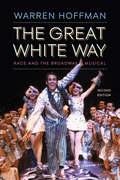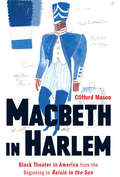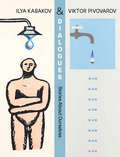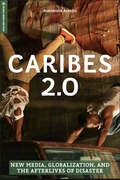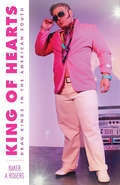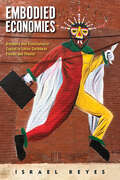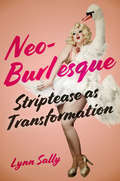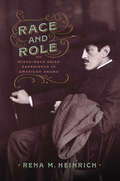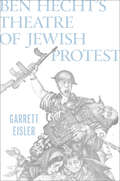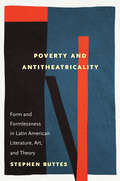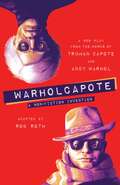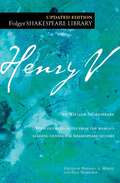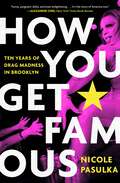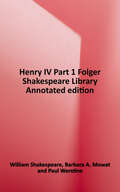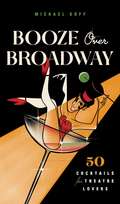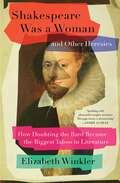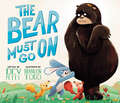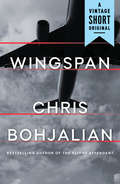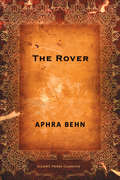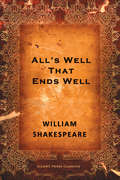- Table View
- List View
Pearl: The Novel
by Tim WaggonerBased on the film written by Ti West and Mia Goth and directed by Ti West The X-traordinary origin story! It’s 1918, and Pearl, a young woman on the brink of madness, must tend to her ailing father under the bitter and overbearing watch of her devout mother. Lusting for the glamorous life she’s seen in the movies, Pearl’s ambitions, temptations, and repressions collide… Written by four-time Bram Stoker Award-winning writer Tim Waggoner, this thrilling novelization is printed in throwback pocket-sized paperback format, bringing Ti West's bloody prequel to a new medium. Go back in time again as Pearl slashes her way to stardom with gory new details drawn from West and Goth's original screenplay.
MaXXXine: The Novel
by Tim WaggonerHer dream was to be a star…but Hollywood can be a killer. In 1985… Adult film star and aspiring actress Maxine Minx finally gets her big break… But as a mysterious killer stalks the starlets of Hollywood, a trail of blood threatens to reveal her sinister past…
Speaking Truths: Young Adults, Identity, and Spoken Word Activism
by Valerie CheppThe twenty-first century is already riddled with protests demanding social justice, and in every instance, young people are leading the charge. But in addition to protesters who take to the streets with handmade placards are young adults who engage in less obvious change-making tactics. In Speaking Truths, sociologist Valerie Chepp goes behind-the-scenes to uncover how spoken word poetry—and young people’s participation in it—contributes to a broader understanding of contemporary social justice activism, including this generation’s attention to the political importance of identity, well-being, and love. Drawing upon detailed observations and in-depth interviews, Chepp tells the story of a diverse group of young adults from Washington, D.C. who use spoken word to create a more just and equitable world. Outlining the contours of this approach, she interrogates spoken word activism’s emphasis on personal storytelling and “truth,” the strategic uses of aesthetics and emotions to politically engage across difference, and the significance of healing in sustainable movements for change. Weaving together their poetry and personally told stories, Chepp shows how poets tap into the beautiful, emotional, personal, and therapeutic features of spoken word to empathically connect with others, advance intersectional and systemic analyses of inequality, and make social justice messages relatable across a diverse public. By creating allies and forging connections based on friendship, professional commitments, lived experiences, emotions, artistic kinship, and political views, this activist approach is highly integrated into the everyday lives of its practitioners, online and face-to-face. Chepp argues that spoken word activism is a product of, and a call to action against, the neoliberal era in which poets have come of age, characterized by widening structural inequalities and increasing economic and social vulnerability. She illustrates how this deeply personal and intimate activist approach borrows from, builds upon, and diverges from previous social movement paradigms. Spotlighting the complexity and mutual influence of modern-day activism and the world in which it unfolds, Speaking Truths contributes to our understanding of contemporary social change-making and how neoliberalism has shaped this political generation’s experiences with social injustice.
Touched Bodies: The Performative Turn in Latin American Art
by Mara Polgovsky EzcurraWhat is the role of pleasure and pain in the politics of art? In Touched Bodies, Mara Polgovsky Ezcurra approaches this question as she examines the flourishing of live and intermedial performance in Latin America during times of authoritarianism and its significance during transitions to democracy. Based on original documents and innovative readings, her book brings politics and ethics to the discussion of artistic developments during the “long 1980s”. She describes the rise of performance art in the context of feminism, HIV-activism, and human right movements, taking a close look at the work of Diamela Eltit and Raúl Zurita from Chile, León Ferrari and Liliana Maresca from Argentina, and Marcos Kurtycz, the No Grupo art collective, and Proceso Pentágono from Mexico. The comparative study of the work of these artists attests to a performative turn in Latin American art during the 1980s that, like photography and film before, recast the artistic field as a whole, changing the ways in which we perceive art and understand its role in society.
The Movie Musical (Quick Takes: Movies and Popular Culture)
by Desirée J. GarciaPutting Asian and European musicals into conversation with Hollywood classics like Singin’ in the Rain and La La Land, this study demonstrates the flexibility and durability of the genre. It explores how the movie musical mediates between nostalgia and technical innovation, while foregrounding the experiences of women, immigrants, and people of color.
The Great White Way: Race and the Broadway Musical
by Warren HoffmanBroadway musicals are one of America’s most beloved art forms and play to millions of people each year. But what do these shows, which are often thought to be just frothy entertainment, really have to say about our country and who we are as a nation? Now in a new second edition, The Great White Way is the first book to reveal the racial politics, content, and subtexts that have haunted musicals for almost one hundred years from Show Boat (1927) to Hamilton (2015). This revised edition includes a new introduction and conclusion, updated chapters, as well as a brand-new chapter that looks at the blockbuster musicals The Book of Mormon and Hamilton. Musicals mirror their time periods and reflect the political and social issues of their day. Warren Hoffman investigates the thematic content of the Broadway musical and considers how musicals work on a structural level, allowing them to simultaneously present and hide their racial agendas in plain view of their audiences. While the musical is informed by the cultural contributions of African Americans and Jewish immigrants, Hoffman argues that ultimately the history of the American musical is the history of white identity in the United States. Presented chronologically, The Great White Way shows how perceptions of race altered over time and how musicals dealt with those changes. Hoffman focuses first on shows leading up to and comprising the Golden Age of Broadway (1927–1960s), then turns his attention to the revivals and nostalgic vehicles that defined the final quarter of the twentieth century. He offers entirely new and surprising takes on shows from the American musical canon—Show Boat (1927), Oklahoma! (1943), Annie Get Your Gun (1946), The Music Man (1957), West Side Story (1957), A Chorus Line (1975), and 42nd Street (1980), among others. In addition to a new chapter on Hamilton and The Book of Mormon, this revised edition brings The Great White Way fully into the twenty-first century with an examination of jukebox musicals and the role of off-Broadway and regional theaters in the development of the American musical. New archival research on the creators who produced and wrote these shows, including Leonard Bernstein, Jerome Robbins, Stephen Sondheim, and Edward Kleban, will have theater fans and scholars rethinking forever how they view this popular American entertainment.
Macbeth in Harlem: Black Theater in America from the Beginning to Raisin in the Sun
by Clifford MasonIn 1936 Orson Welles directed a celebrated all-black production of Macbeth that was hailed as a breakthrough for African Americans in the theater. For over a century, black performers had fought for the right to perform on the American stage, going all the way back to an 1820s Shakespearean troupe that performed Richard III, Othello, and Macbeth, without relying on white patronage. "Macbeth" in Harlem tells the story of these actors and their fellow black theatrical artists, from the early nineteenth century to the dawn of the civil rights era. For the first time we see how African American performers fought to carve out a space for authentic black voices onstage, at a time when blockbuster plays like Uncle Tom’s Cabin and The Octoroon trafficked in cheap stereotypes. Though the Harlem Renaissance brought an influx of talented black writers and directors to the forefront of the American stage, they still struggled to gain recognition from an indifferent critical press. Above all, "Macbeth" in Harlem is a testament to black artistry thriving in the face of adversity. It chronicles how even as the endemic racism in American society and its theatrical establishment forced black performers to abase themselves for white audiences’ amusement, African Americans overcame those obstacles to enrich the nation’s theater in countless ways.
Dialogues: Ilya Kabakov and Vikor Pivovarov, Stories about Ourselves
by Tomas GlancArtists in the Soviet Union faced a difficult choice: either join the official academies and make art that conformed to the state’s aesthetic and ideological dictates, or attempt to develop alternative artistic practices and spheres for exhibiting their work. In the early 1970s, conceptual artists Ilya Kabakov and Viktor Pivovarov chose the latter option, turning their limited resources into an asset by pioneering an entirely new artistic genre: the album. Somewhere between drawings and novels, Kabakov and Pivovarov’s albums were also the basis for unique performance pieces, as the artists invited select audiences to their Moscow apartments for private readings and viewings of the albums, helping to cultivate an alternative artistic community in the process. This exhibition catalog brings together Kabakov and Pivovarov’s key works for the first time, putting the two artists in dialogue and recreating their artistic community. It not only includes nearly hundred pages of full-color illustrations, but also provides complete English translations of the Russian texts that appear in the volume, plus new interviews with each artist. Taken together, they give viewers a new appreciation of the different aesthetic strategies each artist used to depict the absurdities of everyday life in the Soviet era. Published in partnership with the Zimmerli Museum.
Caribes 2.0: New Media, Globalization, and the Afterlives of Disaster (Global Media and Race)
by Jossianna ArroyoIn Caribes 2.0, author Jossianna Arroyo looks at the Caribbean mediasphere in the twenty-first century. Arroyo argues that we have seen a return to tropes such as blackface, brownface, cultural and ethnic stereotypes, and violent representations of the poor, the marginalized, and the racialized. Caribes 2.0 looks at these tropes as well as the work of writers, vloggers, performers, and photographers that have become media figures or have used new media platforms to promote their work and examines how they are challenging and negotiating these media representations. It analyzes contemporary Caribbean cultures to discuss, taste, guides, and actions (social and virtual) that shape Caribbean global communities today. Departing from Edouard Glissant’s insight that “Caribbean reality might not be accessed by remote control” the book considers what types of political and social agencies are created by mediation. Caribes 2.0 deviates from these historical-globalized views of subjected, colonized Caribbean bodies, and their material conditions, to examine the relationship between the local and the global in contemporary Caribbean cultures, and the role that media is playing in the invisibility or hyper-visibilty of Caribbean cultures in the islands and the U.S. diaspora.
King of Hearts: Drag Kings in the American South
by Baker A. RogersWhile drag subcultures have gained mainstream media attention in recent years, the main focus has been on female impersonators. Equally lively, however, is the community of drag kings: cis women, trans men, and non-binary people who perform exaggerated masculine personas onstage under such names as Adonis Black, Papi Chulo, and Oliver Clothesoff. King of Hearts shows how drag king performers are thriving in an unlikely location: Southern Bible Belt states like Tennessee, Georgia, and South Carolina. Based on observations and interviews with sixty Southern drag kings, this study reveals how they are challenging the region’s gender norms while creating a unique community with its own distinctive Southern flair. Reflecting the region’s racial diversity, it profiles not only white drag kings, but also those who are African American, multiracial, and Hispanic. Queer scholar Baker A. Rogers—who has also performed as drag king Macon Love—takes you on an insider’s tour of Southern drag king culture, exploring its history, the communal bonds that unite it, and the controversies that have divided it. King of Hearts offers a groundbreaking look at a subculture that presents a subversion of gender norms while also providing a vital lifeline for non-gender-conforming Southerners.
Embodied Economies: Diaspora and Transcultural Capital in Latinx Caribbean Fiction and Theater (Latinidad: Transnational Cultures in the United States)
by Israel ReyesHow do upwardly mobile Latinx Caribbean migrants leverage their cultural heritage to buy into the American Dream? In the neoliberal economy of the United States, the discourse of white nationalism compels upwardly mobile immigrants to trade in their ties to ethnic and linguistic communities to assimilate to the dominant culture. For Latinx Caribbean immigrants, exiles, and refugees this means abandoning Spanish, rejecting forms of communal inter-dependence, and adopting white, middle-class forms of embodiment to mitigate any ethnic and racial identity markers that might hinder their upwardly mobile trajectories. This transactional process of acquiring and trading in various kinds of material and embodied practices across traditions is a phenomenon author Israel Reyes terms “transcultural capital,” and it is this process he explores in the contemporary fiction and theater of the Latinx Caribbean diaspora. In chapters that compare works by Lin-Manuel Miranda, Nilo Cruz, Edwin Sánchez, Ángel Lozada, Rita Indiana Hernández, Dolores Prida, and Mayra Santos Febres, Reyes examines the contradictions of transcultural capital, its potential to establish networks of support in Latinx enclaves, and the risks it poses for reproducing the inequities of power and privilege that have always been at the heart of the American Dream. Embodied Economies shares new perspectives through its comparison of works written in both English and Spanish, and the literary voices that emerge from the US and the Hispanic Caribbean.
Neo-Burlesque: Striptease as Transformation
by Lynn SallyThe neo-burlesque movement seeks to restore a sense of glamour, theatricality, and humor to striptease. Neo-burlesque performers strut their stuff in front of audiences that appreciate their playful brand of pro-sex, often gender-bending, feminism. Performance studies scholar and acclaimed burlesque artist Lynn Sally offers an inside look at the history, culture, and philosophy of New York’s neo-burlesque scene. Revealing how twenty-first century neo-burlesque is in constant dialogue with the classic burlesque of the nineteenth and twentieth centuries, she considers how today’s performers use camp to comment on preconceived notions of femininity. She also explores how the striptease performer directs the audience’s gaze, putting on layers of meaning while taking off layers of clothing. Through detailed profiles of iconic neo-burlesque performers such as Dita Von Teese, Dirty Martini, Julie Atlas Muz, and World Famous *BOB*, this book makes the case for understanding neo-burlesque as a new sexual revolution. Yet it also examines the broader community of “Pro-Am” performers who use neo-burlesque as a liberating vehicle for self-expression. Raising important questions about what feminism looks like, Neo-Burlesque celebrates a revolutionary performing art and participatory culture whose acts have political reverberations, both onstage and off.
Race and Role: The Mixed-Race Asian Experience in American Drama
by Rena M. HeinrichMixed-race Asian American plays are often overlooked for their failure to fit smoothly into static racial categories, rendering mixed-race drama inconsequential in conversations about race and performance. Since the nineteenth century, however, these plays have long advocated for the social significance of multiracial Asian people. Race and Role: The Mixed-Race Experience in American Drama traces the shifting identities of multiracial Asian figures in theater from the late-nineteenth century to the present day and explores the ways that mixed-race Asian identity transforms our understanding of race. Mixed-Asian playwrights harness theater’s generative power to enact performances of “double liminality” and expose the absurd tenacity with which society clings to a tenuous racial scaffolding.
Ben Hecht's Theatre of Jewish Protest
by Garrett EislerBen Hecht is most remembered as a famous Hollywood screenwriter and Broadway playwright, but only recently has his extensive Jewish activism during the Holocaust and its aftermath received scholarly attention. Unlike other, more expansive Hecht biographies, this book focuses in depth on his Jewish political theatre, drawing on extensive archival research of four dramas: We Will Never Die (1943), A Jewish Fairy Tale (1944), A Flag Is Born (1946), and The Terrorist (1947). Garrett Eisler's readings of these little-known (and out of print) texts reclaim them as pivotal to the history of Jewish American drama, being among the first works of U.S. theatre to address the Holocaust. The full texts of all four works are republished here for the first time, along with production details and full performance histories. Hecht also introduced a new heroic Jewish identity to the American stage, one that challenged popular stereotypes of villainy or weakness. This powerful and (still) controversial body of work stands as a striking testament to the power of theatre to rise to the moment. In Hecht's use of the stage to aggressively engage with history as it was happening, his story is a compelling case of an artist who made a difference.
Poverty and Antitheatricality: Form and Formlessness in Latin American Literature, Art, and Theory
by Stephen ButtesPoverty and Antitheatricality argues that many major analytical approaches today misunderstand the problem of poverty by emphasizing its status as an experience. These experiential models transform poverty from a specific socioeconomic status lived in a particular historical sequence into a transhistorical presence of marginality that is not only inevitable but necessary. Embedded in capitalist, socialist, and populist forms of socioeconomic organization, these models paradoxically suggest that if we want to have a world free of poverty, we must always have the poor and their experience of formlessness. Taking up the paired terms—form and formlessness—Stephen Buttes demonstrates how they sustain not only debates about poverty and its political role within modernity but also the idea of the work of art within the history of modernism. Offering critiques of critical theory alongside new readings of both canonical and little-studied Latin American authors and artists, Poverty and Antitheatricality makes a compelling case that understanding the kind of problem the work of art is opens up overlooked but essential pathways to understanding poverty and the kind of problem it is.
WARHOLCAPOTE: A Non-Fiction Invention
by Rob RothAn enthralling play based on lost tapes between two cultural giants and friends—Andy Warhol and Truman Capote.In 1978 Andy Warhol and Truman Capote decided to write a Broadway play. Andy suggested that he record their private conversations over the period of a few months, and that these tapes would be the source material for the play. The tapes were then filed away and forgotten. Their play was never completed. Now, award-winning director Rob Roth brings their vision to life after a years-long search to unearth the eighty hours of tapes between two of the most daring artists of postwar America. WARHOLCAPOTE, based on words actually spoken by the two men, is set in the &’70s and &’80s, toward the end of their close connection and not too long before their untimely deaths. Their special, complex friendship is captured by Roth with bracing intimacy as they discuss life, love, and art and everything in between. Every word in the play comes directly from these two 20th century geniuses. The structure of the conversations springs from Roth&’s imagination.
Henry V: Updated Edition (Folger Shakespeare Library)
by William Shakespeare Barbara A. Mowat Paul WerstineThe authoritative edition of William Shakespeare’s historic play Henry V from the Folger Shakespeare Library, the trusted and widely used Shakespeare series for both students and general readers. Henry V is Shakespeare’s most famous “war play”; it includes the storied English victory over the French at Agincourt. Some of it glorifies war, especially the choruses and Henry’s speeches urging his troops into battle. But we also hear bishops conniving for war to postpone a bill that would tax the church, and soldiers expecting to reap profits from the conflict. Even in the speeches of Henry and his nobles, there are many chilling references to the human cost of war. The authoritative edition of Henry V from the Folger Shakespeare Library includes: –Freshly edited text based on the best early printed version of the play –Newly revised explanatory notes conveniently placed on pages facing the text of the play –Scene-by-scene plot summaries –A key to the play’s famous lines and phrases –An introduction to reading Shakespeare’s language –An essay by a leading Shakespeare scholar providing a modern perspective on the play –Fresh images from the Folger Shakespeare Library’s vast holdings of rare books –An up-to-date annotated guide to further reading –An essay by Catherine Belsey The Folger Shakespeare Library in Washington, DC, is home to the world’s largest collection of Shakespeare’s printed works, and a magnet for Shakespeare scholars from around the globe. In addition to exhibitions open to the public throughout the year, the folder offers a full calendar of performances and programs. For more information, visit Folger.edu.
How You Get Famous: Ten Years of Drag Madness in Brooklyn
by Nicole PasulkaA madcap adventure through a tight-knit world of drag performers making art and mayhem in the greatest city on earth.Ten years ago, an aimless coat check girl better known today as Merrie Cherry sweet-talked her boss into giving her $100 to host a drag show at a Brooklyn dive bar. Soon, kids like Aja were kicking their way into the scene, sneaking into clubs, pocketing their tips to help mom pay the mortgage, and sharing the stage with electric performers like Thorgy Thor and Sasha Velour. Because suddenly, in the biggest, brightest city in America, drag was offering young, broke, creative queer people a chance at real money—and for thousands or even millions of people to learn their names. In How You Get Famous, journalist Nicole Pasulka joyfully documents the rebirth of the New York drag scene, following a group of iconoclastic performers with undeniable charisma, talent, and a hell of a lot to prove. The result is a sweeping portrait of the 21st-century search for celebrity and community, as well as a chronicle of all the struggles, fights, and disappointments along the way. A rollicking account of the quest to make a living through an art form on the cusp of becoming a cultural phenomenon, How You Get Famous offers an unmissable romp through the gritty and glamorous world of Brooklyn drag.
Henry IV, Part 1 (Folger Shakespeare Library)
by William ShakespeareThe authoritative edition of Henry IV, Part 1 from The Folger Shakespeare Library, is the trusted and widely used Shakespeare series for students and general readers. Family relationships are at the center of Henry IV, Part 1. King Henry IV and Prince Hal form one major father-son pair, with Henry in despair because Hal lives a dissolute life. The father-son pair of Hotspur (Lord Henry Percy) and his father, the Earl of Northumberland, is in seeming contrast; the King envies Northumberland "his Harry," wishing he could claim the gallant Hotspur as his own. Meanwhile, Hal has entered into a quasi-father-son relationship with a disreputable but amusing knight, Sir John Falstaff. Another strand of action centers on still more family relationships. Hotspur's stand against Henry focuses on Hotspur's brother-in-law, Mortimer. Mortimer, who fought against the Welsh magician Owen Glendower, was defeated and captured and has married Glendower's daughter. King Henry pronounces Mortimer a traitor whom he will not ransom. Hotspur, in declaring war on Henry, sees himself as fighting for Mortimer, his wife's brother. <p><p>This edition includes: <p>•Freshly edited text based on the best early printed version of the play <p>•Full explanatory notes conveniently placed on pages facing the text of the play <p>•Scene-by-scene plot summaries <p>•A key to the play's famous lines and phrases <p>•An introduction to reading Shakespeare's language <p>•An essay by a leading Shakespeare scholar providing a modern perspective on the play
Booze Over Broadway: 50 Cocktails for Theatre Lovers
by Tiller PressEnjoy a delicious cocktail while belting out Broadway tunes with this witty guidebook that perfectly pairs your favorite showtunes and Broadway musicals with innovative libations.Do you have a strong love for Andrew Lloyd Weber or Stephen Sondheim? Do you consider &“Defying Gravity&” to be the ultimate, underrated karaoke song? Then get ready to raise your glass and belt out that high-C with Booze Over Broadway. Featuring 50 delectable drinks from a rising star in the New York City bar scene, this clever and creative manual allows you to make delicious cocktails right from the comfort of your home. This witty, accessible book also includes commentary, step-by-step instructions, and whimsical illustrations throughout. Recipes include: -Hello, Daquiri! -The Best Little Whiskey Sour in Texas -Don&’t Cry for Me, Appletini -I Don&’t Know How to Love Gin -Bloody, Bloody, Mary Jackson -Once on this (Long) Island Iced Tea -Brandy Alexander Hamilton -If I Were a Rich Man(hattan) -And more! Fresh and fun, Booze Over Broadway will have cocktail connoisseurs and Broadway buffs alike screaming &“encore!&” (and &“cheers&”).
Shakespeare Was a Woman and Other Heresies: How Doubting the Bard Became the Biggest Taboo in Literature
by Elizabeth WinklerAn &“extraordinarily brilliant&” and &“pleasurably naughty&” (André Aciman) investigation into the Shakespeare authorship question, exploring how doubting that William Shakespeare wrote his plays became an act of blasphemy…and who the Bard might really be.The theory that Shakespeare may not have written the works that bear his name is the most horrible, unspeakable subject in the history of English literature. Scholars admit that the Bard&’s biography is a &“black hole,&” yet to publicly question the identity of the god of English literature is unacceptable, even (some say) &“immoral.&” In Shakespeare Was a Woman and Other Heresies, journalist and literary critic Elizabeth Winkler sets out to probe the origins of this literary taboo. Whisking you from London to Stratford-Upon-Avon to Washington, DC, she pulls back the curtain to show how the forces of nationalism and empire, religion and mythmaking, gender and class have shaped our admiration for Shakespeare across the centuries. As she considers the writers and thinkers—from Walt Whitman to Sigmund Freud to Supreme Court justices—who have grappled with the riddle of the plays&’ origins, she explores who may perhaps have been hiding behind his name. A forgotten woman? A disgraced aristocrat? A government spy? Hovering over the mystery are Shakespeare&’s plays themselves, with their love for mistaken identities, disguises, and things never quite being what they seem. As she interviews scholars and skeptics, Winkler&’s interest turns to the larger problem of historical truth—and of how human imperfections (bias, blindness, subjectivity) shape our construction of the past. History is a story, and the story we find may depend on the story we&’re looking for. &“Lively&” (The Washington Post), &“fascinating&” (Amanda Foreman), and &“intrepid&” (Stacy Schiff), Shakespeare Was a Woman and Other Heresies will forever change how you think of Shakespeare…and of how we as a society decide what&’s up for debate and what&’s just nonsense, just heresy.
The Bear Must Go On
by Dev PettyIn this hilarious story of theatrical hijinks, plans go awry when four woodland friends stage a show--unless Bear can step up and save the day!Bear and his woodland friends are putting on a show, and there are lots of plans to be made. Their curtains need sequins! Their hats must be very, very tall! And their tickets have to be shiny! (No one will come if the tickets are dull.)Behind the scenes, shy Bear takes notes on every detail until his paws ache. But at least he won't have to go on stage. He could NEVER do that!. . . Or could he?In this uproarious tale of theatrical mishaps told with hilariously endearing art, four woodland friends bring down the house--and have plenty of fun along the way.Praise for The Bear Must Go On:"A snort-inducing lesson of both bravery and preparation." --Kirkus Reviews"The rewarding finale . . . applauds facing one's fears, being a good friend, and keeping an eye on the big picture." --Publishers Weekly"Witty and wonderful . . . A cheerful story, conveying the joy of creation, the fun of friendship, and the beauty of stepping outside one's comfort zone." --Booklist"Youngsters who find the spotlight too bright might be inspired by Bear's turn on the stage, and show stealers may also reconsider and revalue the contributions of pals who stay behind the scenes." --BCCB"This playful and endearing story offers young readers a heartfelt message about collaboration and overcoming fear, making it an excellent choice for most collections." --SLJ
Wingspan
by Chris BohjalianOriginally produced as a one-act play starring Grace Experience and K.K. Glick, Wingspan is the story of a young flight attendant with a fear of flying, who is about to work her first transatlantic trip. When a veteran co-worker tries to help her through the turbulent crossing, she discovers that a fear of flying is the least of the young woman’s secrets. A Vintage Shorts Original. An ebook short.
The Rover or, The Banished Cavaliers
by Aphra BehnThe Rover or The Banish'd Cavaliers (1677) is a play in two parts that is written by the English female author Aphra Behn. It is a revision of Thomas Killigrew's play Thomaso, or The Wanderer (1664), and depicts the amorous adventures of a group of Englishmen in Naples at Carnival time. According to Restoration poet John Dryden, it "lacks the manly vitality of Killigrew's play, but shows greater refinement of expression." The play stood for three centuries as "Behn's most popular and most respected play." The Rover features multiple plot lines, dealing with the amorous adventures of a group of Englishmen in Naples at Carnival time.
All's Well That Ends Well: A Comedy
by William ShakespeareHelena schemes with Diana to fulfill Bertram's stipulations and win his love, but as Bertram's infidelity and Helena's deceits are revealed, the audience is left to wonder if, in love, the end justifies the means.
